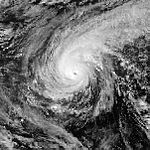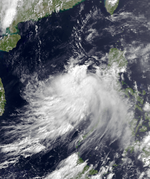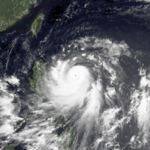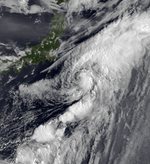1988 Pacific typhoon season
| 1988 Pacific typhoon season | |
|---|---|

Season summary map
|
|
| Seasonal boundaries | |
| First system formed | January 5, 1988 |
| Last system dissipated | December 25, 1988 |
| Strongest storm | |
| Name | Nelson |
| • Maximum winds | 185 km/h (115 mph) (10-minute sustained) |
| • Lowest pressure | 915 hPa (mbar) |
| Seasonal statistics | |
| Total depressions | 28 |
| Total storms | 27 |
| Typhoons | 11 |
| Super typhoons | 1 |
| Total fatalities | >542 |
| Total damage | > $1.3 billion (1988 USD) |
| Related articles | |
| Typhoon (JMA) | |
| Category 4 typhoon (SSHWS) | |
| Duration | January 7 – January 19 |
|---|---|
| Peak intensity | 155 km/h (100 mph) (10-min) 940 hPa (mbar) |
| Typhoon (JMA) | |
| Category 1 typhoon (SSHWS) | |
| Duration | May 28 – June 3 |
|---|---|
| Peak intensity | 120 km/h (75 mph) (10-min) 970 hPa (mbar) |
| Tropical storm (PAGASA) | |
| Tropical depression (SSHWS) | |
| Duration | June 3 – June 6 |
|---|---|
| Peak intensity | 65 km/h (40 mph) (10-min) 1000 hPa (mbar) |
| Typhoon (JMA) | |
| Category 1 typhoon (SSHWS) | |
| Duration | June 17 – June 25 |
|---|---|
| Peak intensity | 130 km/h (80 mph) (10-min) 970 hPa (mbar) |
| Severe tropical storm (JMA) | |
| Tropical storm (SSHWS) | |
| Duration | June 25 – June 29 |
|---|---|
| Peak intensity | 100 km/h (65 mph) (10-min) 990 hPa (mbar) |
| Typhoon (JMA) | |
| Category 4 typhoon (SSHWS) | |
| Duration | July 11 – July 20 |
|---|---|
| Peak intensity | 165 km/h (105 mph) (10-min) 940 hPa (mbar) |
| Severe tropical storm (JMA) | |
| Tropical storm (SSHWS) | |
| Duration | July 27 – August 1 |
|---|---|
| Peak intensity | 95 km/h (60 mph) (10-min) 975 hPa (mbar) |
| Tropical storm (JMA) | |
| Tropical depression (SSHWS) | |
| Duration | July 30 – August 3 |
|---|---|
| Peak intensity | 65 km/h (40 mph) (10-min) 998 hPa (mbar) |
| Tropical storm (JMA) | |
| Tropical storm (SSHWS) | |
| Duration | August 4 – August 9 |
|---|---|
| Peak intensity | 85 km/h (50 mph) (10-min) 985 hPa (mbar) |
The 1988 Pacific typhoon season has no official bounds; it ran year-round in 1988, but most tropical cyclones tend to form in the northwestern Pacific Ocean between May and November. These dates conventionally delimit the period of each year when most tropical cyclones form in the northwestern Pacific Ocean. Tropical Storms formed in the entire west Pacific basin were assigned a name by the Joint Typhoon Warning Center. Tropical depressions that enter or form in the Philippine area of responsibility are assigned a name by the Philippine Atmospheric, Geophysical and Astronomical Services Administration or PAGASA. This can often result in the same storm having two names.
A total of 26 tropical cyclones formed this year in the Western Pacific, of which all became tropical storms. Of the 26, 10 storms reached typhoon intensity, of which 1 reached supertyphoon strength. Nine tropical cyclones moved through the Philippines this season, making this season the most active for the archipelago so far this decade.
A total of 26 tropical cyclones formed this year in the Western Pacific, of which all became tropical storms. Of the 26, 10 storms reached typhoon intensity, of which 1 reached supertyphoon strength. Nine tropical cyclones moved through the Philippines this season.
Typhoon Roy, which crossed the open Western Pacific as a Category 4 typhoon in January, caused moderate to extensive damage across the Federated States of Micronesia and the Philippines, causing $23.5 million (1988 USD) but only one death.
Typhoon Susan formed at the end of May just to the north of Luzon Island in the Philippines. As a depression Susan dropped heavy rains in and around the Manila area the resulting landslides killed 6 people. As Susan moved away from the Philippines the storm strengthened into a typhoon shortly before cross in the southern tip of Taiwan and turning extratropical just after passing Okinawa.
...
Wikipedia

















